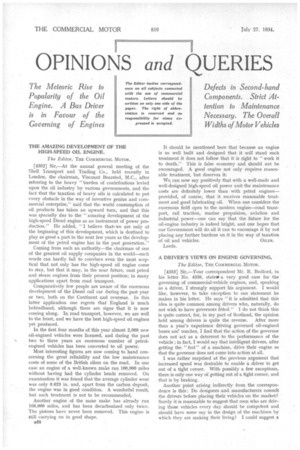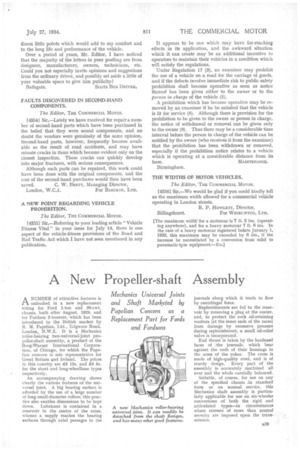OPINIONS and QUERIES
Page 56

Page 57

If you've noticed an error in this article please click here to report it so we can fix it.
THE AMAZING DEVELOPMENT OF THE HIGH-SPEED OIL ENGINE.
The Editor, THE COMMERCIAL MOTOR.
[4352] Sir,--At the annual general meeting of the Shell lransport and Trading Co., held recently in London, the chairman, Viscount Bearsted, M.C., after referring to the heavy " burden of contributions levied upon the oil industry by various governments, and the fact that the taxation of heavy oils is calculated to put every obstacle in the way of inventive genius and commercial enterprise," said that the world consumption of oil products has taken an upward turn, and that this was specially due to the "amazing development of the high-speed Diesel engine as an instrument of power production." He added, "I believe that' we are only at the beginning of this development, which is destined to play as great a part in the next few years as the development of the petrol engine has in the past generation."
Coining from such an authority—the chairman of one of the greatest oil supply companies in the world—such words can hardly fail to convince even the most sceptical that not only has the high-speed oil engine come to stay, but that it may, in the near future, oust petrol and steam engines from their present position; in many applications apart from road transport.
Comparatively few people are aware of the enormous development of the Diesel rail car during the past year or two, both on the Continent and overseas. In this latter application one regrets that England is much behindhand, although there are signs that it is now coming along. In road transport, however, we are well to the front, and we have the best high-speed oil engines yet produced.
In the first four months of this year almost 2,000 new oil-engined vehicles were licensed, and during the past two to three years an enormous number of petrolengined vehicles has been converted to oil power.
Most interesting figures are now coming to hand concerning the great reliability and the low maintenance costs of some of the British oilers on the road. In one case an engine of a well-known make ran. 100,000 miles without having had the cylinder heads removed. On examination it was found that the average cylinder wear was only 0.023 in. and, apart from the carbon deposit, the engine was in good condition. A wonderful result, but such treatment is not to be recommended.
Another engine of the same make has already run 168,000 miles, and has been decarbonized only twice. The pistons have never been removed. This engine is still carrying on in good shape.
B8 It should be mentioned here that because an engine is• so well built and designed that it will stand such treatment it does not follow that it is right to "work it to death." This is false economy and should not be encouraged. A good engine not only requires reasonable treatment, but deserves it.
We, can now say positively that with a well-made and well-designed high-speed oil power unit the maintenance costs are definitely lower than with petrol engines— provided, of course, that it receives reasonable treatment and good lubricating oil. When one considers the enormous field open to the modern engine—road transport, rail traction, marine propulsion, aviation and industrial power—one can say that the future for the oil-engine industry is indeed bright, and one hopes that our Government will do all it can to encourage it by not placing any further burdens on it in the way of taxation of oil and vehicles. OILER. Leeds.
A DRIVER'S VIEWS ON ENGINE GOVERNING.
The Editor, Tug COMMERCIAL MOTOR.
[4353] Sir,—Your correspondent Mr, R. Bedford, in his letter No. 4338, states' a very good case for the governing of commercial-vehicle engines, and, speaking as a driver, I strongly support his argument. I would like, however, to take exception to one statement he makes in his letter. He says " it is admitted that this idea is quite common among drivers who, naturally, do not wish to have governors fitted." I do not think this is quite correct, for, in my part of Scotland, the opinion held among drivers is quite the reverse. After more than a year's experience driving governed oil-engined buses an ':oaches, I find that the action of the governor does not act as a deterrent to the performance of the vehicle ; in fact, I would say that intelligent drivers, after getting the " feel " of a machine, drive their engine so that the governor does not come into action at all.
I was rather surprised at the previous argument that increased speed was desirable to enable a driver to get out of a tight corner. With possibly a few exceptions, there is only one way of getting out of a tight corner, and that is by braking.
Another point arising indirectly from the correspondence is this: Do designers and manufacturers consult the drivers before placing their vehicles on the market? Surely it is reasonable to suggest that men who are driving those vehicles every day should be competent and should have some say in the design of the machines by which they are making their living? I could suggest a dozen little points which would add to my comfort and to the long life and performance of the vehicle.
Over a period of years, Mr. Editor, I have noticed that the majority of the letters in your postbag are from designers, manufacturers, owners, technicians, etc. Could you not especially invite opinions and suggestions from the ordinary driver, and possibly set aside a little of your valuable space to give him publicity?
Bathgate. SCOTS Bus DRIVER, FAULTS DISCOVERED IN SECOND-HAND COMPONENTS.
The Editor, THE COMMERCIAL MOTOR.
[43541 Sir,—Lately we have received for repair a number of second-hand parts which have been purchased in the belief that they were sound components, and no doubt the vendors were genuinely of the same opinion. Second-hand parts, however, frequently become available as the result of road accidents, and may have minute cracks in them which become evident only on the closest inspection. These cracks can quickly develop into major fractures, with serious consequences.
Although such parts can be repaired, this work could have been done with the original components, and the cost of the second-hand purchases would then have been saved. C. W. BRETT, Managing Director, London, W.C.1. For BARIMAR, LTD.
A NEW POINT REGARDING VEHICLE PROHIBITION.
The Editor, THE COMMERCIAL MOTOR.
[4355] Sir,—Referring to your leading article "Vehicle Fitness Vital" in your issue for July 13, there is one aspect of the vehicle-fitness provisions of the Road and Rail Traffic Act which I have not seen mentioned in any publication. It appears to be one which may have far-reaching effects in its application, and the awkward situation which it can create may be an additional incentive to operators to maintain their vehicles in a condition which will satisfy the regulations.
Under Regulation 17 (3), an examiner may prohibit the use of a vehicle on a road for the carriage of goods, and if the defects involve immediate risk to public safety prohibition shall become operative as soon as notice thereof has been given either to the owner or to the person in charge of the vehicle (5).
A prohibition which has become operative may be removed by an examiner if he be satisfied that the vehicle is fit for service (6). Although there is provision for the prohibition to be given to the owner or person in charge, the notice of withdrawal or removal can be given only to the owner (9). Thus there may be a considerable time interval before the person in charge of the vehicle can be notified by the owner (who receives it from the examiner) that the prohibition has been withdrawn or removed, especially if the prohibition notice relates to a vehicle which is operating at a considerable distance from its base. MAINTENANCE. Birmingham.
THE WIDTHS OF MOTOR VEHICLES.
The Editor, `THE COMIVIERCIAL MOTOR.
[43561 Sir,—We would be glad if you could kindly tell us the maximum width allowed for a commercial vehicle operating in London streets.
R. P. HOWLETT, Director, Billingshurst. For WHIRLWIND, LTD.
[The maximum widthfor a motorcar is 7 ft. 2 ins. (operating anywhere), and for a heavy motorcar 7 ft. 6 ins. In the case of a heavy motorcar registered before January 1, 1932, this maximum may be exceeded by 6 ins., if the increase be necessitated by a conversion from solid to pneumatic-tyre equipment—ED.]




































































































